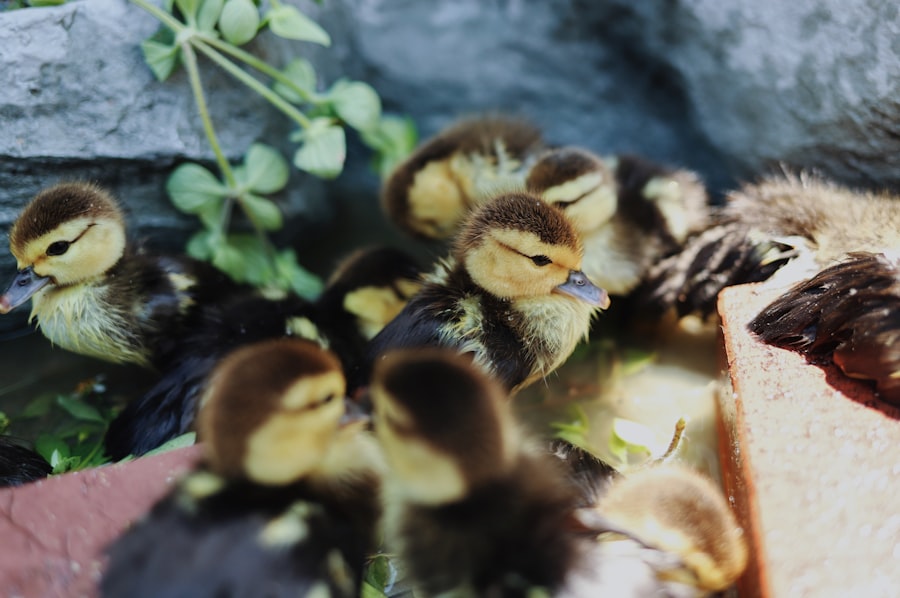The meat duck industry is a thriving sector of the poultry industry that focuses on breeding ducks specifically for meat production. Ducks are known for their flavorful and tender meat, making them a popular choice for consumers around the world. The demand for duck meat has been steadily increasing in recent years, driven by factors such as changing consumer preferences, cultural traditions, and the rise of international cuisines.
Breeding ducks for meat offers several advantages over other types of poultry. Ducks are known for their efficient feed conversion, meaning they can convert feed into meat more efficiently than other poultry species. This makes them a cost-effective option for meat production. Additionally, ducks have a higher dressing percentage compared to chickens and turkeys, which means a higher proportion of their body weight can be used for meat. Ducks also have a higher fat content, which contributes to the flavor and tenderness of the meat.
Key Takeaways
- Breeding ducks for meat is a profitable venture that requires proper knowledge and management.
- Selecting the right breeds for meat production is crucial for achieving high-quality meat.
- Understanding the nutritional requirements of meat ducks is essential for their growth and development.
- Proper housing and management practices are necessary for the health and well-being of meat ducks.
- Feeding strategies that promote optimal growth and development should be implemented for maximum profitability.
Selecting the Right Breeds for Meat Production
When it comes to breeding ducks for meat production, there are several popular breeds to choose from. Some of the most common meat duck breeds include the Pekin duck, Muscovy duck, and Rouen duck. Each breed has its own unique characteristics and advantages.
The Pekin duck is the most widely used breed in the meat duck industry due to its fast growth rate and high feed conversion efficiency. Pekin ducks have a white plumage and yellow skin, making them visually appealing to consumers. They also have a mild flavor and tender meat, making them suitable for a wide range of culinary applications.
Muscovy ducks are another popular choice for meat production. They have a leaner meat compared to Pekin ducks and are known for their distinctive flavor. Muscovy ducks also have a higher dressing percentage and lower fat content, making them a healthier option for consumers.
Rouen ducks are often used as a dual-purpose breed, meaning they can be raised for both meat and eggs. They have a slower growth rate compared to Pekin ducks but are known for their flavorful meat and attractive plumage.
When selecting a breed for meat production, it is important to consider certain characteristics. Look for breeds that have a fast growth rate, good feed conversion efficiency, and a high dressing percentage. It is also important to consider the market demand for different breeds in your area.
Understanding the Nutritional Requirements of Meat Ducks
Proper nutrition is essential for the optimal growth and development of meat ducks. Ducks have different nutritional needs at different stages of growth, so it is important to provide them with a balanced diet that meets their specific requirements.
During the first few weeks of life, ducklings require a diet that is high in protein to support their rapid growth. A starter feed with a protein content of around 20-24% is recommended during this stage. As the ducks grow older, the protein content of their diet can be gradually reduced.
Once the ducks reach the grower stage, they require a diet with a lower protein content, typically around 16-18%. This helps to promote proper muscle development and prevent excessive fat deposition. It is also important to provide ducks with access to fresh water at all times, as they have a higher water requirement compared to other poultry species.
In addition to protein, ducks also require other essential nutrients such as carbohydrates, fats, vitamins, and minerals. It is important to provide them with a balanced diet that contains all of these nutrients in the correct proportions. Commercially available duck feeds are formulated to meet the nutritional needs of meat ducks at different stages of growth.
Housing and Management of Meat Ducks
Proper housing and management are crucial for the health and well-being of meat ducks. Ducks require a clean and comfortable environment that protects them from extreme weather conditions and predators.
The housing requirements for meat ducks depend on the breed, flock size, and local climate. However, there are some general guidelines that can be followed. Ducks should be provided with enough space to move around comfortably and engage in natural behaviors such as preening and bathing. The housing should be well-ventilated to prevent the buildup of ammonia and other harmful gases. It should also be easy to clean and disinfect to maintain good hygiene.
Bedding material such as straw or wood shavings should be provided to keep the ducks comfortable and absorb moisture. Nesting boxes or areas should also be provided for ducks that are laying eggs.
In terms of management, it is important to monitor the ducks regularly for signs of illness or stress. Ducks should be provided with clean water and feed at all times. It is also important to practice good biosecurity measures to prevent the spread of diseases.
Feeding Strategies for Optimal Growth and Development
Feeding plays a crucial role in the growth and development of meat ducks. A well-balanced diet that meets their nutritional needs is essential for optimal meat production.
Feeding schedules for meat ducks can vary depending on the breed, age, and growth stage. In general, ducks should be fed multiple times a day to ensure they have access to fresh feed at all times. This helps to promote healthy growth and prevent overeating.
The type of feed used for meat ducks can also vary depending on availability and cost. Commercially available duck feeds are formulated to meet the nutritional needs of meat ducks at different stages of growth. These feeds typically contain a balanced mix of protein, carbohydrates, fats, vitamins, and minerals.
In addition to commercial feeds, ducks can also be supplemented with other feed sources such as grains, vegetables, and insects. This can help to provide additional nutrients and promote natural foraging behaviors.
It is important to monitor the ducks’ feed intake and adjust the feeding program as needed. Overfeeding can lead to excessive fat deposition and poor meat quality, while underfeeding can result in stunted growth and reduced meat production.
Health Management Practices for Meat Ducks

Maintaining the health of meat ducks is essential for the success of a breeding operation. Ducks are susceptible to a variety of diseases and health issues, so it is important to implement preventative measures and monitor the ducks regularly.
Some common health issues in meat ducks include respiratory infections, parasites, and nutritional deficiencies. Ducks should be vaccinated against common diseases and provided with regular veterinary care. Good biosecurity measures should also be practiced to prevent the introduction and spread of diseases.
Proper sanitation and hygiene are important for maintaining the health of meat ducks. The housing should be cleaned and disinfected regularly to prevent the buildup of pathogens. Ducks should also have access to clean water at all times, as contaminated water can lead to disease outbreaks.
It is important to monitor the ducks regularly for signs of illness or stress. This includes observing their behavior, appetite, and appearance. Any abnormalities should be addressed promptly to prevent further complications.
Processing and Marketing of Meat Ducks
Once the ducks have reached the desired weight for processing, they can be prepared for sale or consumption. Processing involves several steps, including slaughter, evisceration, and packaging.
Slaughter should be done in a humane and efficient manner to minimize stress on the ducks. The ducks should be stunned before slaughter to ensure a quick and painless death. After slaughter, the ducks are eviscerated to remove the internal organs and prepared for packaging.
Packaging is an important step in the processing of meat ducks. The meat should be packaged in a way that preserves its freshness and quality. This can include vacuum-sealing, freezing, or using other preservation methods.
Marketing strategies for selling meat ducks can vary depending on the target market and local regulations. Some breeders sell their ducks directly to consumers through farmers markets, online platforms, or on-farm sales. Others may sell their ducks to restaurants, grocery stores, or other foodservice establishments.
It is important to have a clear marketing plan in place to reach the target market and differentiate the product from competitors. This can include branding, advertising, and building relationships with potential customers.
Maximizing Profitability in Meat Duck Breeding
Breeding ducks for meat can be a profitable venture if managed effectively. There are several cost-effective ways to breed meat ducks and strategies for increasing profits in the industry.
One cost-effective way to breed meat ducks is to optimize feed efficiency. Ducks have a high feed conversion efficiency, but it is important to minimize feed wastage and ensure that the ducks are receiving a balanced diet. This can be achieved through proper feeding management and regular monitoring of feed intake.
Another way to increase profitability is to maximize the use of resources. This includes utilizing available land, water, and labor efficiently. Ducks can be raised in free-range systems or integrated with other agricultural activities to make the most of available resources.
Strategies for increasing profits in the meat duck industry include value-added products and diversification. Value-added products can include processed duck products such as sausages, smoked duck breast, or duck confit. Diversification can involve expanding into other areas such as breeding breeding stock or selling duck eggs.
Challenges and Risks in Breeding Ducks for Meat
Breeding ducks for meat comes with its own set of challenges and risks. It is important to be aware of these challenges and have strategies in place to mitigate risks and overcome obstacles.
One potential challenge in the meat duck industry is disease outbreaks. Ducks are susceptible to a variety of diseases, some of which can have devastating effects on a breeding operation. Implementing good biosecurity measures and working closely with a veterinarian can help to prevent and manage disease outbreaks.
Another challenge is market volatility. The demand for duck meat can fluctuate depending on factors such as consumer preferences, economic conditions, and competition from other meat products. It is important to have a flexible marketing plan and diversify the customer base to mitigate the risks associated with market volatility.
Other challenges in the meat duck industry include rising input costs, regulatory compliance, and labor availability. It is important to stay informed about industry trends and developments to adapt to changing conditions.
Future Trends in the Meat Duck Industry
The meat duck industry is constantly evolving, driven by changing consumer preferences, technological advancements, and environmental concerns. There are several emerging trends that are shaping the future of meat duck breeding and production.
One emerging trend is the demand for organic and free-range duck meat. Consumers are increasingly seeking out products that are produced using sustainable and ethical practices. This includes ducks that are raised without antibiotics or hormones and have access to outdoor areas.
Another trend is the use of technology in meat duck production. This includes the use of precision farming techniques, such as automated feeding systems and data analytics, to optimize production efficiency and reduce environmental impact.
There is also a growing interest in alternative feed sources for meat ducks. This includes the use of insect-based feeds, plant-based feeds, and by-products from other industries. These alternative feed sources can help to reduce the reliance on traditional feed ingredients such as soybean meal and corn.
In conclusion, breeding ducks for meat is a profitable venture that offers several advantages over other types of poultry. Selecting the right breeds, understanding their nutritional requirements, providing proper housing and management, implementing feeding strategies, managing health issues, processing and marketing effectively, maximizing profitability, mitigating risks, and staying informed about future trends are all essential for success in the meat duck industry. With careful planning and management, breeders can meet the growing demand for duck meat and contribute to a sustainable and thriving industry.
If you’re interested in breeding ducks for meat, you may also find this article on poultrywizard.com helpful. It provides valuable insights on how to build an A-frame chicken coop, which can be adapted for ducks as well. A well-designed coop is essential for the health and productivity of your birds, and this article offers step-by-step instructions and tips to ensure your ducks have a comfortable and secure living space. Check it out here: A-Frame Chicken Coop.
FAQs
What is breeding ducks for meat?
Breeding ducks for meat is the process of raising ducks specifically for their meat. This involves selecting the right breed, providing proper nutrition, and ensuring good living conditions to produce high-quality meat.
What are the best breeds of ducks for meat production?
The best breeds of ducks for meat production are the Pekin, Muscovy, and Rouen. These breeds are known for their fast growth, high meat yield, and good meat quality.
What is the ideal living condition for ducks raised for meat?
The ideal living condition for ducks raised for meat is a clean and spacious environment with access to clean water and proper nutrition. Ducks should also be protected from predators and extreme weather conditions.
What is the feeding requirement for ducks raised for meat?
Ducks raised for meat require a balanced diet that includes a combination of grains, protein, and vitamins. They should also have access to clean water at all times.
What is the average lifespan of ducks raised for meat?
The average lifespan of ducks raised for meat is around 8-12 weeks. This is the ideal time to harvest them for their meat.
What is the best age to harvest ducks for meat?
The best age to harvest ducks for meat is between 8-12 weeks. At this age, ducks have reached their maximum weight and their meat is of high quality.
What are the benefits of breeding ducks for meat?
Breeding ducks for meat can provide a sustainable source of high-quality protein. It can also be a profitable business venture for farmers and can help support local food systems.
Meet Walter, the feathered-friend fanatic of Florida! Nestled in the sunshine state, Walter struts through life with his feathered companions, clucking his way to happiness. With a coop that’s fancier than a five-star hotel, he’s the Don Juan of the chicken world. When he’s not teaching his hens to do the cha-cha, you’ll find him in a heated debate with his prized rooster, Sir Clucks-a-Lot. Walter’s poultry passion is no yolk; he’s the sunny-side-up guy you never knew you needed in your flock of friends!







